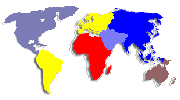|
From “Washington” Towards
A “Vienna Consensus”?
By Arno Tausch
Abstract
This publication empirically evaluates and develops core aspects of the literature on global governance. Analyzing
world social, gender, ecological and economic development on the basis of the main 9 predictors, compatible with the majority of the more than 240 published studies on the cross
-national determinants of the “human condition” around the globe, it presents the results of 32 equations about development performance from 131 countries. We come to
the conclusion that while there is some confirmation for the “blue”, market paradigm as the best and most viable way of world systems governance concerning economic growth, re
-distribution and gender issues, the “red-green” counter-position is confirmed concerning such vital and basic indicators as life expectancy and the human development index.
This work also challenges the neo-liberal consensus about democracy and the pure market economy as the way to
development, equality, a good environment and peace by showing that selected market interventions and the fairly regulated regime of the early post-war years assured stability
in Europe and Japan and contributed to social and economic recovery from the Great Depression and the Second World War. Present attempts to stabilize the world order by bringing
in the major western industrialized countries plus Russia (the so-called G-8, composed by France; United States; United Kingdom; Russian Federation; Germany; Japan; Italy;
Canada; European Union) must face up to the fact that these countries represent a declining part of world purchasing power. The rise of Asia makes the present G7/G8 structure increasingly irrelevant.
This publication also re-establishes the notion that capitalist development is of cyclical nature, with strong
fluctuations every 50 years. For us 1756, 1832, 1885, 1932 and 1975 are the beginnings of new Kondratiev waves, while 1756, 1774, 1793, 1812, 1832, 1862, 1885, 1908, 1932, 1958
, 1975, and 1992 are the turning points (troughs) of the Kuznets cycles. Vigorous upswings of the capitalist world economy need to be supported by a tightly organized new
world political hegemonic order, while the strength of the downswings and the severity of the depressions always are a function of the waning world political order. We show the
fatal interconnection between these world political and world economic “tsunami waves” in a more systematic fashion. In the most recent phase of capitalism, its “Casino” character
becomes ever more apparent, with a sharp distinction between the winners and losers of the system.
So, where are we now? 1870? 1913? 1938? World systems theory is full of speculation about the future, and much of
world systems research writing projects a major global war by around 2020 or 2030. The danger arises that instability and not democratization will triumph in the end in the countries of
the periphery and the semi-periphery, especially in countries like those of the former USSR. We are especially preoccupied about the economic growth and war intensity connection
that seems to have evolved in the world system, if not earlier, than at least since 1946. It is entirely possible that a military Keynesian consensus will emerge in the world system,
but that will be a consensus towards warfare.
We also show that Europe’s crisis is not caused by what the neo-liberals term a “lack of world economic openness”
but rather, on the contrary, by the enormous amount of passive globalization that Europe – together with Latin America – experienced over recent years. Our combined
measure of the velocity of the globalization process is based on the increases of capital penetration over time, on the increases of economic openness over time, and on the
decreases of the comparative price level over time: the United States, Mexico, Venezuela, larger parts of Africa and large sections of West and South Asia escaped from the
combined pressures of globalization, while Eastern and Southern Latin America, very large parts of Europe, Uzbekistan, Mongolia, Thailand and Malaysia, Russia and
China were characterized by a specially high tempo of globalization.
The “wider Europe” of the EU-25 is not too distantly away from the social realities of the more advanced Latin American
countries. From the viewpoint of world systems theory, especially from the angle of the “Re-Orient” sub-school, initiated by the late Andre Gunder Frank, such tendencies are
not a coincidental movement along the historic ups and downs of social indicators, but the very symptom of a much more deeper-rooted crisis, which is the beginning of the real
re-marginalization and re-peripherization of the European continent.
So, what should be done? By the governments of the world, and by the globalization critical social movements? Only a
movement towards global democracy is the valid answer to the fact that the peoples of the world live in a single global social system. The establishment of a European democratic
federal state would be the first and most important step in the direction of a socio-liberal world democracy.
JEL Classification: C21, D31, E30, F02
Key words: Cross-Section Models, Income Distribution, Prices, Business Fluctuations, and Cycles – General;
International Economic Order, Inequality, Economic Integration: General

|



